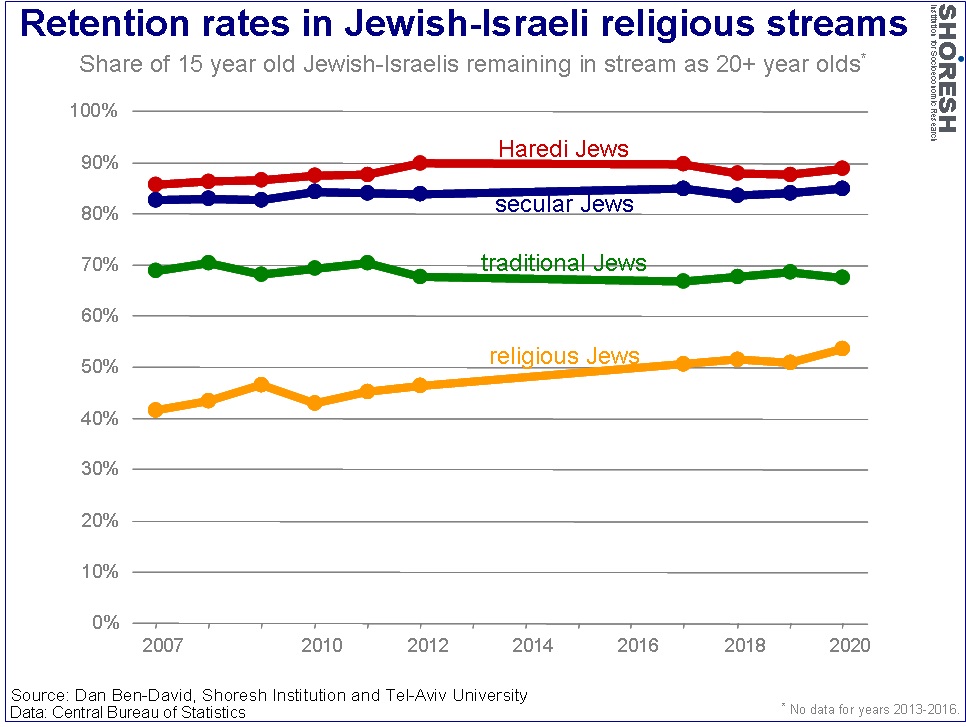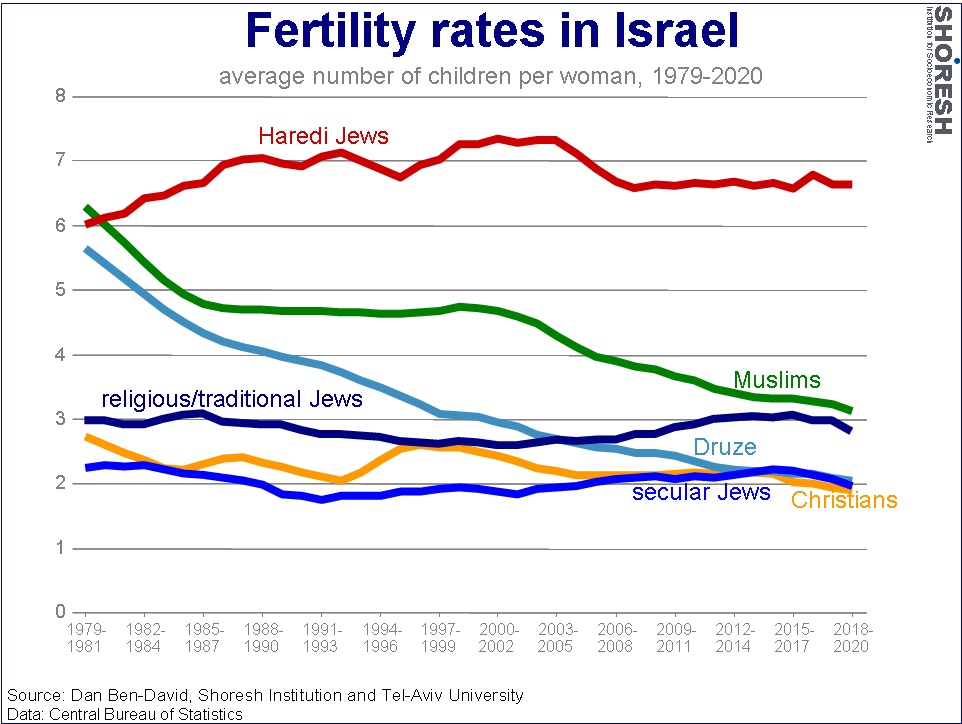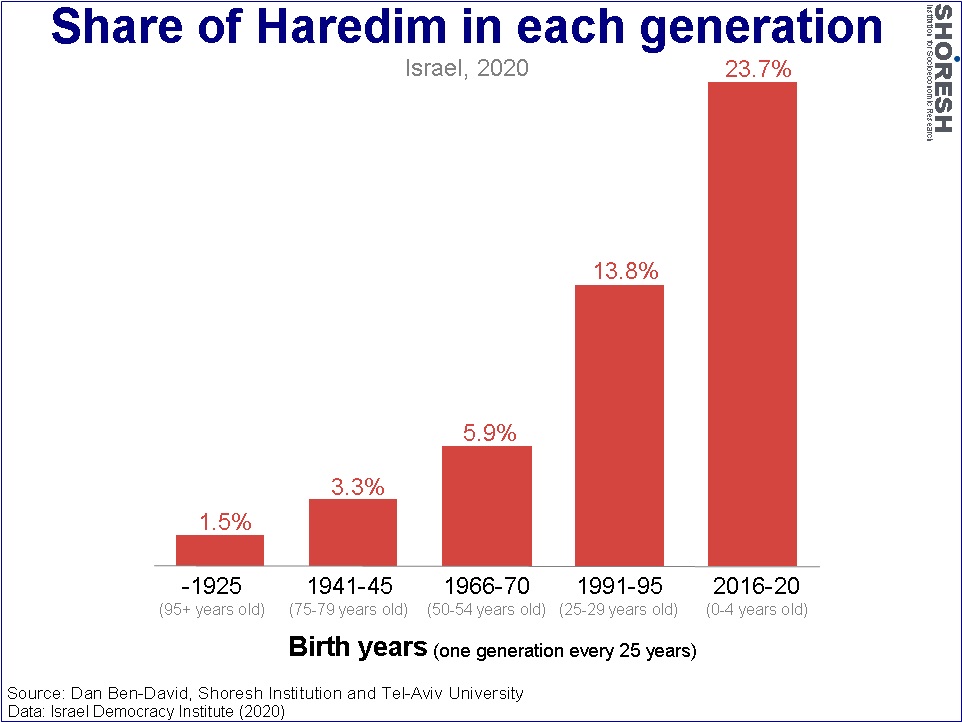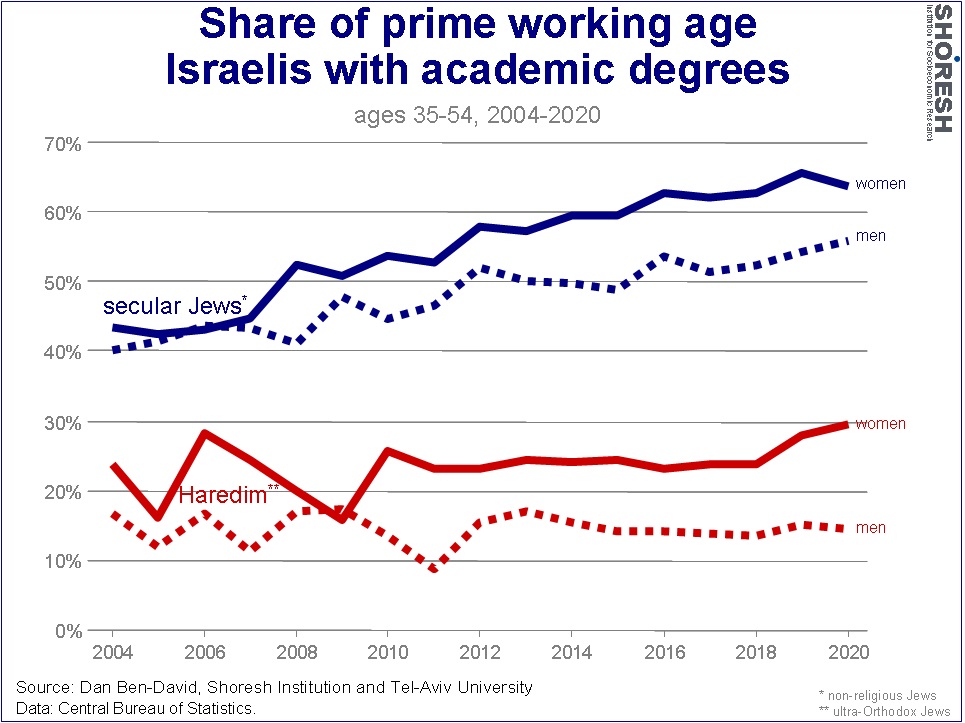|
published
in Times of Israel
on March 14, 2023. Part 3 of 5 Be fruitful and multiply – illusions and facts
about Israel’s haredim by Dan Ben-David While the share of Haredim in Israel’s population doubles every 25
years, Haredi leaders deprive their children of the basic education necessary
for global economy and modern democracy The 1967 Six-Day War led to a chasm between Israel’s right and left that
only deepened over the years. A decade
later, in 1977, the right took over the government helm for the first time. This also marked the first time that the
haredim (ultra-Orthodox Jews) became a part of the governing coalition – and,
in the process, became Israel’s political kingmakers between the right and the
left. With the exception of just a
handful of years since 1977, the haredim have sided with the right. The one- or two-state solution to the Palestinian conflict have been
secondary considerations for the haredi parties. Their primary demands were – and continue to
be – enabling their men to evade compulsory military service alongside
depriving their children of a core curriculum that would provide them with
serious opportunities to work in a competitive global economy and a serious
understanding of the underpinnings of modern democracies. On top of all this, the haredi politicians
demanded, and received, considerable government aid that led to extraordinarily
high fertility rates (rising from 6 to 7 children per woman in just the decade
after they joined the government) that in turn fed their perpetually growing
electoral base, while enabling lifestyles of non-work – primarily among
men. While conventional wisdom in Israel is that haredi males never worked,
the facts suggest otherwise. Over 80% of
prime working age (35-54) haredi males were employed in the late 1970s. This fell to under 40% in just three decades. Only when some of the benefits that they
received were cut during the major recession brought on by the Second Intifada
did haredi male employment begin to rise slightly. To avoid having to reconcile their differences with regard to the future
of the territories occupied in 1967 and their inhabitants, both right and left
have been willing to pay the haredim’s price for nearly half a century,
mortgaging the country’s future for political expediency in the present. This myopic unwillingness to come to terms
with what such a future will bring was ostensibly based on an assumption – fed
by very partial anecdotal evidence – that as the haredi population grew and
became exposed to modern society, an increasing share of its members would
decide to work and study – and possibly even leave the haredi lifestyle. The problem in a modern society bombarded with factoids is that many
people tend to take anecdotes, or partial bits of information, that support
what they hope is occurring, and turn these into narratives that they convince
themselves are empirically based. However, when examining only selected parts
of the full picture, one tends to see a misleading and deceptive depiction of
reality. Contrary to the assumptions of many, the share of haredim remaining in
the religious stream that they grew up in is neither low nor is it
falling. In fact, just the opposite is
true. Haredi retention rates are the
highest among all the Jewish streams in Israel, and they are very stable – even
rising slightly during the last decade and a half.

When taking into account where individuals who left their childhood
streams ended up as adults, it turns out that the adult haredi population is
18% larger than all those who grew up as haredim.

However, the above data do not tell the entire story regarding the
direction that Israel’s Jewish population is headed because it does not take
into account haredi fertility rates. Not only do just a negligible number of
haredim leave the stream that they grew up in, their fertility rates are also
more than triple those of Israel’s secular Jews. And contrary to many common beliefs, Haredi
fertility rates are not falling. They
have been constant at third world levels (6.6 children on average per haredi
woman) during the past a decade and a half.

When all three of the above points are combined, the implication is that
the haredi share in Israel’s population is doubling every 25 years (i.e. every
generation), from 1.5% of all people 95 and up, through 3.3% for people in
their upper seventies, 5.9% for people in their low fifties, 13.8% for people
in their twenties and 23.7% for infants and toddlers. The Central Bureau of Statistics forecasts
that in just four decades, one-half of Israel’s children ages 0-14 will be
haredim.

In other words, the share of adult haredim in Israel’s population is
low, and has been low for many years.
This, in turn, leads many to feel that there is really no problem here,
and that “we will deal with this when we absolutely have to”. But haredi
population growth reflects an exponential function, and this is exactly how
such functions work. For a very long period of time, the problem seems minor
and under control. This causes general anesthesia among those who do not
understand the difference between a linear function and an exponential one. To illustrate this point, suppose that just one thousandth of a
milliliter (0.001 milliliter) of water is put into a one-liter (1,000
milliliter) bottle, and in each period the amount of water in the bottle is
doubled. How many periods will it take until the bottle is full? In other
words, how many periods will it take for the first amount to increase a million
times over? It takes 10 periods to reach only half a milliliter. But it takes only 5
additional periods to reach 16 milliliters. In another 5 periods, half of the
bottle is full – and it takes just one more period to replicate what was done
in all 20 previous periods to fill up the other half of the bottle. During Israel’s first decades, when the number of adult haredim was low
and appeared to be changing slowly, Israeli society preferred to focus on the
issues that appeared to be more urgent, looking for and grasping reassuring
bits of information that reinforced the very Israeli attitude of “everything
will be okay” (yi’hiye beseder). As
such, many did not feel the need to open up a front against the haredi
leadership and demand that their children study a core curriculum as is
required in every other developed country.
Instead, people preferred to rely on prevailing gut feelings that adult
haredim can overcome having not learned core studies as children. This belief
is seemingly buttressed by the increase in the number of haredim who embark
upon an academic track, despite the very low level of basic education that they
received as children. But what is important is not the increasing number of individuals – out
of a population group that is itself growing very rapidly – who embark on the
academic track. What matters is how many of them manage to survive the track
and actually receive an academic degree.
According to the State Comptroller’s Office, over half of the women
(53%) and over three-quarters of the men (76%) drop out of the track that
includes pre-academic preparation and subsequent academic studies – even though
the vast majority of this study was at very low level academic
institutions. Contrary to the fantasies
in the minds of many Israelis, there has been absolutely no change in the share
of haredim receiving an academic degree (apart from a small increase among
haredi women in the last two years) during the past two decades.

Like filling the bottle with water, Israel’s period from independence
until the turn of the Millennium resembles the first 10 periods that it took to
fill the entire bottle (i.e., half of the necessary periods). Israel’s last 20
years are perhaps the more similar to the next five periods in filling the
bottle – when people begin to recognize the problem, but still think there is
time to take care of it. However, when the issue is not dealt with while it is
still possible to do so, the bottle starts to fill up at an increasing rate,
until it explodes when it can no longer contain what is inside it. Israel is hurtling forward toward a clearly unsustainable future, fueled
in large part by an exponentially growing society of mostly well-meaning
haredim led by cynics and opportunists – and in the case of the Shas
leadership, a repeat offender convicted of corruption charges – intent on
depriving their own community of any exposure to existing knowledge that would
enable them to live and think independently of their leaders’ dictates. When this becomes an existential issue for
Israel as a whole, there is a need to say enough is enough. Every developed country – including Israel – requires all children to go
to school. Because these are innate
rights that all children have to ensure that they have an opportunity at a
future, no country asks parents if this coincides with their beliefs. Similarly, all developed countries – except
Israel – require that this be an actual education by mandating a set of core
requirements that each child must study.
It is time for Israel to join the family of developed nations in this
regard. Receipt of a full core
curriculum will enable haredim to choose any lifestyle they wish, providing
them with the requisite tools to independently support themselves, and to make
fertility decisions for which they alone will have to be responsible. The accompanying reduction in welfare
benefits that have disproportionately gone their way will help sharpen the
focus for all those needing a reminder of the importance of getting a good
education and making decisions with regard to the number of children that they
can support. |